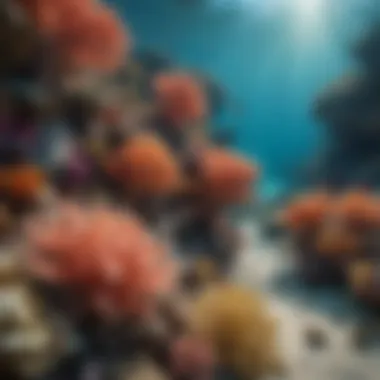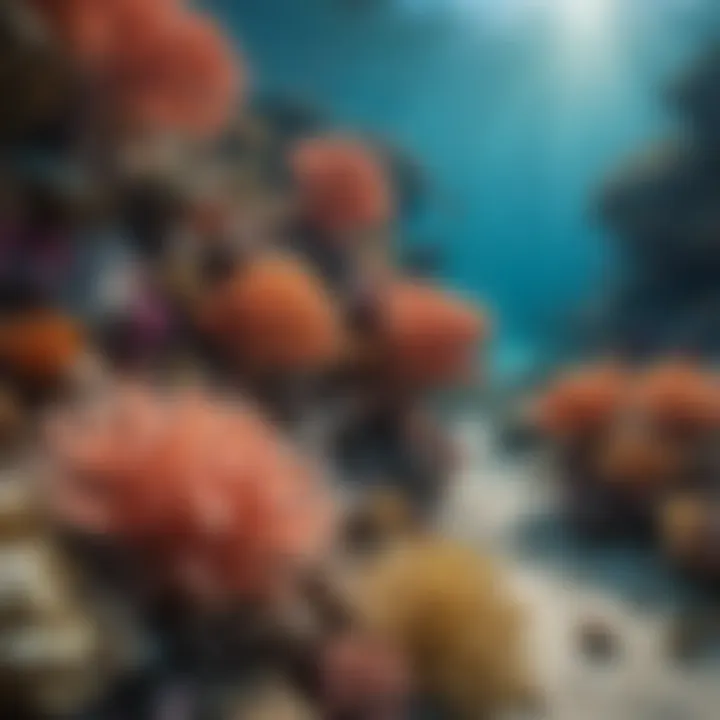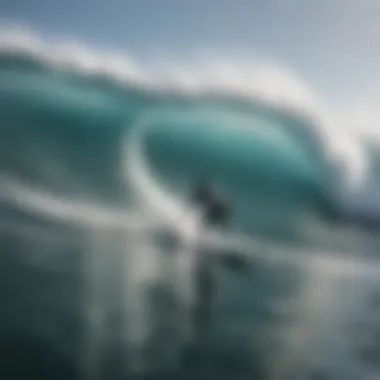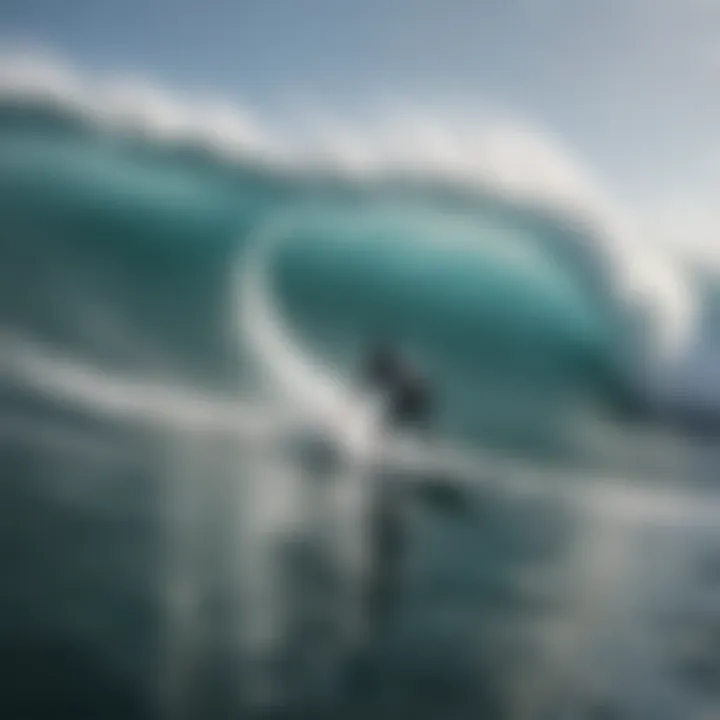Exploring the Seas: A Global Perspective on Waterways


Intro
The world’s oceans and seas are more than just vast bodies of water. They’re intricate ecosystems, cultural treasures, and stages for thrilling adventures. In this exploration, we’ll uncover the unique traits of various seas, their ecological importance, and how they intertwine with human activities. Understanding the seas not only enriches our knowledge – it connects us with the planet we live on.
Each sea has its own identity shaped by geography, climate, and life. From bustling coastal environments teeming with life to serene, secluded spots perfect for watersports, the diversity is astounding. This article looks at the seas not just as places to visit, but as vital components of our global ecosystem and as reservoirs of culture and history.
Planning a watersport adventure requires a solid grasp of the skills needed, the importance of safety, and the right gear. Over the course of this guide, we will delve into these aspects, offering insights tailored for both novices and seasoned enthusiasts. Let’s dive in!
Prelims to the Seas
Seas play a pivotal role in shaping our world. They are not just bodies of water; they are complex ecosystems and cultural treasures, that influence climate, biodiversity, and human life. In this section, we will explore what defines seas and their significance in human culture. Understanding these aspects will lay the foundation for a deeper dive into the various seas across the globe, their unique characteristics, and the relationship we have fostered with these aquatic environments over centuries.
Defining the Seas
When we talk about seas, we often think of vast blue expanses offering scenic views or the cradles of thrilling adventures. Technically speaking, seas are smaller than oceans, partially enclosed by land, and interconnected with them. This distinct boundary offers a unique set of conditions.
Seas come in diverse forms — some are rich in nutrients, while others may be more saline and less vibrant. Take the Caribbean Sea, for instance. It's known for its warm waters and vibrant coral reefs. On the other hand, the North Sea near Europe exhibits a quite different environment, being colder and less salty than those tropical counterparts.
The definitions may vary, but the essence remains: seas are critical to understanding our planet's aquatic framework.
The Importance of Seas in Human Culture
Seas are woven into the fabric of cultures worldwide. From ancient civilizations that relied on them for sustenance and trade to modern societies that view them as spaces for recreational activities, their impact is undeniable. They serve as pathways for exploration, migration, and even conflict.
Here are a few ways in which seas have influenced human culture:
- Trade and Economy: Historically, seas were more than just a means of transportation; they were highways for trade, connecting disparate regions and facilitating commerce. Think of the Mediterranean Sea, which has long been a bustling artery of trade between Europe, Africa, and Asia.
- Cultural Identity: Many coastal communities have developed unique identities shaped by their relationship with the sea. The Maori of New Zealand view the ocean as an ancestor, highlighting the spiritual connection people can have with these waters.
- Art and Literature: Seas have inspired countless works of art, from romantic poems about the sea's mysteries to modern novels that explore human nature through nautical adventures. Popular literature, such as Moby-Dick, captures the intrigue and challenges presented by marine life.
"The sea, once it casts its spell, holds one in its net of wonder forever." – Jacques Cousteau
In summary, seas are essential not just for their ecological roles but for how they have shaped human culture, identity, and history. This foundational understanding sets the stage for further exploration into specific seas and their distinctive qualities.
Major Seas Around the Globe
When we set sail into the vastness of our planet's waters, the geographical significance of the various seas comes into sharper focus. This part of the article underscores the importance of understanding these waters, not merely as blue regions on a map. Rather, they are living ecosystems that support biodiversity and sustain human life and industry. From shipping routes that drive global trade to the calming beauty that attracts tourists, these seas hold immense value for various cultures and economies.
The Caribbean Sea
The Caribbean Sea, known for its crystalline waters and vibrant marine life, serves as a paradise for water sports enthusiasts. Stretching for 2.754 million square kilometers, it is bordered by more than twenty countries. Each island is a microcosm of unique ecosystems; the coral reefs are among the most diverse features in the world. They offer not just stunning snorkelling and diving opportunities but act as protective barriers for shorelines, absorbing the impact of waves.
However, while tourism thrives – with locales like Saint Lucia, Aruba, and the Bahamas luring hordes of visitors – the delicate balance of marine life is under threat. Overfishing and pollution have placed this sea in a precarious position, necessitating conscientious efforts to preserve its beauty and health for future generations.
The Mediterranean Sea
This ancient sea is both a historian’s playground and an adventurer’s dream. The Mediterranean hosts an intricate tapestry of cultures, threaded through its coastline that reaches across Europe, Africa, and Asia. The sea spans approximately 2.5 million square kilometers and boasts thousands of islands, each steeped in myths and stories.
Notably, the Mediterranean is famed for its rich biodiversity. The waters teem with life, from colorful fish to vital seagrass meadows. These ecosystems not only support wildlife but also contribute to the economy through tourism, fishing, and shipping. As the backdrop of numerous historical events, the Mediterranean continues to shape civilizations. However, the rising threats from climate change and pollution are creating ripple effects, affecting both marine ecosystems and the communities that rely on them.
The South China Sea
Flanked by several nations, the South China Sea is more than just a body of water; it’s a geopolitical hotspot. Stretching over 3.5 million square kilometers, it is critical for international shipping, with about a third of global maritime trade passing through its waters. Naturally, this economic significance is counterbalanced by numerous territorial disputes among nations claiming rights to parts of this sea.
Rich in natural resources like oil and natural gas, the sea also boasts extensive coral reefs and diverse marine habitats. The biodiversity present, including various shark species and marine turtles, makes it an important site for biodiversity conservation. However, the region has faced high levels of fishing pressure and habitat destruction, underscoring the urgent need for cooperative management of these waters.
The Red Sea
The Red Sea is a diver's delight, due to its extraordinary coral reefs and marine life diversity, including species found nowhere else on earth. It’s a narrow sea, about 2,238 kilometers long, lying between Europe, Asia, and Africa. The unique conditions here, such as high salinity and temperature, have fostered resilient marine ecosystems.
Historically significant, this sea was a trading route known to ancient civilizations. But today, it is also a stage for modern marvels of marine tourism. Resorts and dive operations thrive, providing exotic glimpses under the waves. Yet, similar to other seas, pollution and climate change threaten its ecosystems. Initiatives to protect marine life are becoming increasingly essential in ensuring the health of this vital body of water.
The Adriatic Sea


Situated between the Italian peninsula and the Balkans, the Adriatic Sea offers a treasure trove of history and natural beauty. Spanning over 138,600 square kilometers, it is known for its calm, blue waters and picturesque coastal towns. The region is celebrated for its rich historical sites, many of which can only be appreciated from the water, such as the stunning islands of Croatia.
The Adriatic is also critical for local economies, especially fishing and tourism, which flourish in its serene ambiance. However, with rising pressures from tourism, over-exploitation, and pollution, concerns about its ecological health are mounting. Protecting the biodiversity of this sea is crucial for sustaining the livelihoods of those who depend on it and ensuring that future generations can enjoy its wonders.
"The seas are not just a backdrop to our lives, but a vital lifeline to our future."
Exploring the seas around the globe opens our eyes to the intricate connections between human activity and marine environments. Each sea holds stories that deserve to be told and protected.
Unique Characteristics of Specific Seas
The seas across the globe are not just vast bodies of water; they’re fertile grounds for a wide array of unique characteristics that define their essence. These attributes have a profound impact on marine ecosystems, influence weather patterns, and even affect human activities. From salinity to biodiversity, understanding these elements opens a window into the complexities of our aquatic environments.
Salinity and Temperature Variations
Salinity and temperature play crucial roles in determining the health and diversity of marine habitats. Salinity, the measure of how much salt is dissolved in water, varies greatly among different seas. For instance, the Mediterranean Sea is known for its higher salinity compared to the surrounding oceans. This increased salinity results from high evaporation rates under the scorching sun and limited freshwater inflow from rivers. The elevated salt levels not only create a unique environment but can also influence local weather patterns.
Temperature, on the other hand, can dictate the types of species that thrive in specific areas. Warm waters often teem with vibrant marine life, as seen in the Coral Triangle located in Southeast Asia, known for its rich biodiversity and stable warm temperatures. Conversely, colder seas like the Laptev Sea or the Southern Ocean support different ecological dynamics. The interaction between salinity and temperature creates gradients that are essential for migration patterns, breeding cycles, and nutrient availability, crucial for sustaining marine life.
"The combination of salinity and temperature variations creates a tapestry of environments that forms the backbone of marine biodiversity across the globe.”
Biodiversity Hotspots
Certain seas are recognized as biodiversity hotspots, serving as crucial habitats for a multitude of species. These areas are not simply gatherings of marine life but are intricately connected ecosystems that house myriad organisms, from the smallest plankton to the mightiest whales. The Great Barrier Reef, for example, epitomizes this concept. It’s not just a popular snorkeling destination; it’s a critical zone containing over 400 species of coral, which in turn support thousands of fish species and other marine life.
Similarly, the Caribbean Sea is celebrated for its vibrant coral reefs and mangroves, which act as nurseries for numerous fish species while also providing significant coastal protection. The interactions within these ecosystems form complex food webs that contribute to the overall health of the marine environment.
Challenges arise when considering human impact, as these hotspots face threats like overfishing, pollution, and climate change. Preserving these unique areas not only safeguards the diverse life within them but also supports the fishing industries and tourism that many coastal communities rely upon. Thus, recognizing and protecting these biodiversity hotspots is not merely an environmental concern but a social one as well.
Ecological Significance of Seas
The seas are more than just expansive bodies of water; they are intricate ecosystems that play a vital role in the health of our planet. As the lungs of the Earth, the oceans are essential in regulating climate patterns, supporting diverse marine life, and providing critical resources for humans. The interrelationship between seas and the processes they govern can hardly be overstated; understanding this ecological significance helps appreciate their protective role against climate change and their influence on global biodiversity.
Role in Climate Regulation
Seas contribute significantly to climate regulation through the absorption of carbon dioxide and heat. Oceans act as carbon sinks, sequestering CO2 from the atmosphere, thus mitigating the greenhouse effect. This natural process plays a crucial part in stabilizing the climate, all the while ensuring that temperatures do not rise at alarming rates.
In addition to carbon absorption, seas help moderate weather and climate by influencing ocean currents, which are instrumental in transporting warm and cold water around the globe. For instance, the Gulf Stream, originating in the Gulf of Mexico, flows across the Atlantic Ocean, warming Western Europe’s climate significantly. Without these currents, regions could experience dramatic shifts in temperature and weather patterns.
Our understanding of where these currents flow and the factors that influence them remains crucial. As the planet warms, these currents may be disrupted, resulting in unpredictable consequences for weather patterns and sea levels. Moreover, mangroves, seagrasses, and coral reefs serve as buffers, protecting coastal areas from storms and erosion.
"The ocean’s health is directly linked to our weather system—if the ocean suffers, so do we."
Importance for Marine Life
The seas are bustling with life, and their ecologies support an estimated 230,000 known marine species, each forming part of an intricate web of interactions. From the majestic blue whale to the tiny plankton drifting in the currents, marine species rely on these ecosystems for survival, breeding, and nutrition. Healthy seas foster biodiversity that not only sustains these species but also contributes to the overall functionality of the planet’s ecosystems.
Coral reefs, often referred to as the rainforests of the sea, are a prime example of how rich marine life thrives in healthy, productive seas. These structures provide habitat for countless fish and marine organisms, serving as nurseries for young species and offering a variety of fishing resources for humans. However, they are incredibly sensitive to temperature changes and pollution.
Furthermore, seas support critical food webs that extend beyond marine life. Numerous terrestrial animals depend on the oceans for nourishment, and humans do, too. It is estimated that about 3 billion people rely on seafood as their primary source of protein.
By valuing and protecting our seas, we ensure the survival of both marine and human populations. The fate of marine life and its intricate relationships define the sea's ecological significance, shaping our understanding of the aquatic world and its essential contributions to life on Earth.
Understanding these vital roles showcases not just the importance of preserving our marine environments but also the profound responsibilities tied to human actions. The seas reflect a living curtain—from climate to biodiversity—that demands our respect and protection.
Human Activities and Their Impact
Human activities have a profound impact on the seas, weaving a complex tapestry of interactions that shape our marine ecosystems and coastal communities. As we delve into this section, it becomes evident that understanding these influences is crucial for fostering sustainable practices and promoting harmony between humanity and our oceanic neighbors. When we consider the vibrant worlds beneath the surface, it's important to recognize how our actions can steer both benefits and challenges in the life of the seas.
Commercial Fishing
Commercial fishing is a vital economic force, providing sustenance and livelihoods for millions worldwide. However, its impact extends far beyond the plates of individuals. Overfishing, a common practice, puts immense pressure on fish stocks, leading to imbalances in marine ecosystems. Some species, like the cod in the North Atlantic or the bluefin tuna in the Mediterranean, have seen dramatic population declines, raising red flags among conservationists.
"Sustainable fishing practices can help ensure the health of our oceans for generations to come."


For instance, implementing fishing quotas can help manage fish populations and allow species to recover. Furthermore, using selective fishing gear minimizes bycatch, which preserves marine biodiversity and maintains ecological balance. Encouraging local fishing communities to embrace sustainable methods can create a ripple effect, fostering stewardship over our precious marine resources.
Shipping and Trade Routes
The seas are not just a boundary between landmasses; they are the lifeblood of global trade. A significant amount of goods—from electronics to agriculture—moves across oceans daily, linking economies and cultures. Major shipping routes, such as those through the Strait of Malacca or the Panama Canal, are crucial for international commerce. However, this frenzy of shipping activity has its nuances.
Maritime traffic results in increased pollution, including oil spills, plastic waste, and noise pollution that disrupts marine life communication and behavior. A notable incident was the Deepwater Horizon oil spill, which wreaked havoc in the Gulf of Mexico, underscoring the potential for catastrophic consequences.
To combat these issues, advancements in shipping technology are essential. Embracing greener alternatives, such as wind-assisted propulsion and improved fuel efficiency, can significantly reduce the carbon footprint of maritime shipping. As we foster innovation in this sector, we must also push for international regulations to safeguard the marine environments involved in trade.
Tourism and Recreation
Tourism is another facet of human activity that has transformed our seas into vibrant destinations for adventure and relaxation. The allure of sun-soaked beaches, crystal-clear waters, and unique marine life captivates millions. However, the environmental costs of such activities can accumulate, often leading to degradation of delicate ecosystems.
Popular activities like diving, snorkeling, and boating can disturb habitats, particularly coral reefs, which are already under stress from climate change. An example is the Great Barrier Reef; the influx of tourists has led to coral bleaching and increased sedimentation.
On the flip side, marine tourism offers opportunities for conservation awareness. When tourists engage with local ecosystems, they often develop a deeper appreciation for preservation efforts. Sustainable tourism practices, like ecotourism, can be mutually beneficial—providing economic incentives for local communities to conserve marine environments. It's a delicate balance, yet one that holds the promise of nurturing both people's connection to the sea and the sea’s vitality for years to come.
The Seas and Watersports
Watersports and seas are two elements that are almost like two sides of the same coin. The vast blue expanses hold adventure, leisure, and a touch of the unknown for enthusiasts. From the gentle waves of the Mediterranean to the roaring swells of the North Pacific, the seas provide environments where thrill-seekers meet nature in exhilarating and intimate ways. This section examines the intersections of several popular watersports activities and the seas that serve as their playgrounds, all while recognizing the importance of sustainable practices in preserving these aquatic wonderlands.
Popular Watersports Locations
When it comes to watersports, certain locations jump off the map, practically screaming for attention. These spots offer not just the ideal conditions but have become hubs for communities steeped in water-related activities. A few notable locales include:
- Gold Coast, Australia: Known for its stunning beaches, the Gold Coast is a paradise for surfers and jet-skiers alike, with consistent waves and breathtaking scenery.
- Bali, Indonesia: Famous for its surfing culture, Bali attracts countless surfers each year. The island also boasts pristine reefs, making it a prime location for divers.
- The Bahamas: With crystal-clear waters, the Bahamas is an idyllic place for snorkeling, sailing, and fishing, all while soaking under the sun in a tropical setting.
- Lake Tahoe, USA: Not a sea, but Lake Tahoe's stunning blue waters provide a different kind of experience, where wakeboarding and paddle boarding are popular pastimes.
- Hawaii, USA: Let’s not forget, Hawaii stands out as the holy grail for many surfers. With waves that range from beginner-friendly to expert-level, it offers something for everyone.
Each of these locations offers unique benefits and experiences, creating vibrant communities focused around their love for the sea and the activities it inspires.
Seas Ideal for Surfing, Sailing, and Diving
Different seas around the world speak to specific activities, capturing the essence of what makes each experience extraordinary.
- Surfing: The Pacific Ocean is a surfer's dream. Locations like Jeffrey’s Bay in South Africa and the North Shore in Hawaii deliver some of the best waves on the planet. The energy of the ocean can be both thrilling and humbling, reminding athletes of its raw power.
- Sailing: The Mediterranean Sea offers gentle winds and sheltered bays, perfect for smooth sailing. Greece, particularly the Cyclades island group, provides not just stunning vistas, but the clear water invites anchorage and exploration of hidden coves.
- Diving: For those diving beneath the waves, the Great Barrier Reef in Australia is often cited as the perfect destination with its unparalleled biodiversity. The clarity of the waters and the color of the coral create an underwater paradise.
Diving into these activities goes beyond the surface. It’s about connecting with the environment, exploring vast underwater worlds, and even learning more about marine conservation.
"These experiences root us deeper in appreciation for the aquatic ecosystems that sustain life, reminding us that our adventures in water come with a responsibility to protect it."
Environmental Concerns
The seas, as vast as they are beautiful, face significant threats that demand our attention. Addressing environmental concerns is crucial in understanding how human activities impact aquatic life and ecosystems. With rising pollution and the ever-looming specter of climate change, it's essential to explore these challenges to protect the country's precious marine resources and the activities they support.
Pollution and Its Effects
Pollution takes many forms in the marine environment, affecting everything from the smallest plankton to large whales. Chemical pollutants like plastics and heavy metals accumulate in ocean waters and sediments, hurting aquatic life. For instance, plastics often break down into microplastics, which enter the food chain, affecting fish populations and, consequently, humans who consume those fish.
A pertinent example of this is the Great Pacific Garbage Patch, a massive area filled with debris located between Hawaii and California. This patch highlights the serious consequences of pollution, not only on wildlife but also on human health and economies dependent on fishing and tourism.
Furthermore, oil spills, such as the infamous Deepwater Horizon disaster in 2010, deliver catastrophic effects to marine ecosystems. Oil coats the surface of the ocean, creating a barrier that prevents sunlight from penetrating the water and thus endangering essential photosynthetic organisms. The aftermath is extensive and costly, with particular species, like sea turtles and dolphins, suffering long-term consequences.
Key Points on Pollution Effects:
- Harmful chemicals disrupt marine ecosystems.
- Microplastics accumulate in the food chain.
- Oil spills have devastating impact on marine life.
"Keeping our seas clean is not just a matter of beauty but of survival—both for marine inhabitants and ourselves."
Climate Change and Rising Sea Levels
Climate change poses an undeniable threat to the seas. It manifests in rising sea levels, which can drown coastal communities, erode beaches, and reduce biodiversity in estuarine areas. As earth's temperature increases, glaciers and ice caps melt, contributing to ocean expansion, leading to lower salinity levels in certain regions. This change can disrupt migratory patterns and spawning grounds for various marine species, which rely on specific environmental conditions for reproduction and survival.
Moreover, warmer sea temperatures affect coral reefs, often leading to phenomena like coral bleaching. Healthy reefs provide essential habitats for countless marine organisms and protect coastlines from erosion. The loss of these reefs threatens not only the marine life they support but also the local economies reliant on tourism and fishing.


To combat climate change, global efforts are underway to reduce carbon emissions and promote sustainable practices. For example, the Paris Agreement encourages nations to limit global warming to below 2 degrees Celsius, aiming to mitigate these environmental impacts and protect marine ecosystems.
Consequences of Climate Change on Oceans:
- Rising sea levels threaten coastal communities.
- Coral reefs experience bleaching from warm waters.
- Ocean acidification affects shellfish and marine ecosystems.
Conservation Efforts
The seas embody a vital part of Earth's ecosystem, serving as a natural resource that sustains life and offers numerous benefits to humanity. In this context, conservation efforts play a critical role in safeguarding these aquatic wonders from the multifaceted pressures they face. Overfishing, pollution, climate change, and habitat destruction are just a few of the threats undermining the health of our seas. Conservation efforts not only aim to protect marine life but also to ensure that future generations can enjoy and benefit from the seas.
Marine Protected Areas
Marine Protected Areas (MPAs) serve as a cornerstone of conservation strategies. These designated regions are crucial because they restrict human activities to varying degrees, allowing ecosystems to recover and thrive. The concept behind MPAs is akin to stepping back from a busy city street and letting nature breathe, so to speak.
Key elements of MPAs include:
- Biodiversity Preservation: MPAs often harbor a variety of species, providing a refuge for endangered and vulnerable marine life. By protecting these areas, we ensure the survival of not just charismatic creatures like sea turtles and sharks, but also the less visible organisms that form the backbone of marine ecosystems.
- Habitat Restoration: Through restrictions on fishing or recreational activities, MPAs enable habitats such as coral reefs and seagrass beds to recover over time. This restoration fosters healthier ecosystems that ultimately contribute to enhanced fisheries and better water quality.
- Research Opportunities: These protected areas also serve as living laboratories. Scientists can study ecosystems in their natural state, providing invaluable insights that can inform broader conservation strategies.
MPAs represent a commitment to conserving not only the fish we catch but also the intricate webs of life that weave together to form our oceans.
International Agreements and Policies
To bolster the effectiveness of marine conservation, international cooperation is increasingly vital. The interconnectedness of our oceans means that harmful practices in one region can have cascading effects elsewhere. Therefore, robust international agreements are essential for the sustainable management of marine resources.
Some key international agreements and policies that impact conservation efforts include:
- The Convention on Biological Diversity (CBD): This treaty emphasizes the importance of biodiversity and advocates for sustainable use and conservation of marine and coastal resources.
- The United Nations Convention on the Law of the Sea (UNCLOS): UNCLOS provides a comprehensive framework outlining nations' rights and responsibilities regarding the use of the world's oceans, encouraging sustainable fishing practices and the protection of marine environments.
- Regional Fisheries Management Organizations (RFMOs): These organizations focus on the cooperative management of fish stocks in specific regions, helping to combat overfishing and promote sustainable practices among member countries.
Through effective implementation of these agreements, nations can work together to achieve shared conservation goals. The policies not only protect marine biodiversity but also enhance the long-term viability of industries that depend on healthy oceans, including fishing, tourism, and recreation.
Future of the Seas
The seas of our planet are more than just vast bodies of water; they are intricate networks that shape weather, support life, and provide for humanity. As we look into the future of the seas, it's clear that the interplay between technological advances and sustainable practices is crucial. This section aims to explore how these elements can safeguard the oceans while unraveling opportunities that may lie beneath the waves.
Technological Advances in Marine Exploration
With the advent of advanced technology, exploring the depths of the seas has become less a sci-fi dream and more a reality. Drones, remotely operated vehicles, and autonomous underwater vehicles enable marine researchers and enthusiasts alike to gather data from areas that were once considered unattainable.
- Sonar Technology: High-resolution sonar systems allow us to map the ocean floor with remarkable precision. This capability unveils not just geographical features but also habitats that harbor undiscovered species.
- Satellite Monitoring: Satellites equipped with remote sensing technology provide valuable information on sea surface temperatures, chlorophyll concentration, and more. These metrics help in understanding ecosystem health and predicting future changes.
- Virtual Reality and Augmented Reality: Using VR and AR, educators and marine advocates bring the ocean's mysteries to classrooms and living rooms. Virtual dives into coral reefs or shipwrecks captivate younger generations, fostering a sense of stewardship for our oceans.
Emerging technologies also promise to push the frontiers of ocean energy, vital for a future less reliant on fossil fuels. Harnessing wave and tidal energy could transform marine landscapes into sustainable energy sources, powering coastal communities and reducing carbon footprints.
Sustainable Practices for Seas Management
The importance of sustainability can't be overstated. As human activity increasingly encroaches on marine ecosystems, adopting responsible practices becomes essential. We need to ensure that the oceans are not merely resources to exploit, but ecosystems to preserve.
- Sustainable Fishing: Overfishing remains a pressing issue. Practices such as catch limits, selective fishing gear, and marine protected areas promote fish population recovery and ecosystem balance.
- Eco-Tourism: Encouraging tourism that emphasizes conservation can lead to a win-win scenario for local economies and environmental health. Places like the Great Barrier Reef offer guided diving experiences that educate visitors on the importance of preservation while supporting local livelihoods.
- Pollution Management: Reducing plastic waste and controlling runoff into oceanic waters are critical. Engaging communities in beach clean-ups and implementing stricter regulations can mitigate pollutants that impact marine life.
The call for global cooperation in marine conservation is louder than ever. Building alliances through international agreements ensures that one country's practices do not undermine another's conservation efforts.
"Sustainable management of the seas is not just an option; it’s an obligation to future generations."
End: The Interconnectedness of Seas and Humanity
The relationship between humans and the seas is a complex tapestry woven over centuries, embracing ways of life, cultures, and economies. This interconnectedness underscores the importance of the seas not just as physical boundaries or ecosystems, but as integral components of human society. The oceans serve as highways for trade, sources of sustenance, and arenas for recreation, while their health directly impacts our well-being. Therefore, understanding this bond is crucial for both current and future generations.
The seas are more than vast bodies of water; they are living entities that sustain a myriad of life forms- both aquatic and terrestrial. As we navigate our places in the world, the seas offer lessons about resilience and balance.
The development of sustainable practices in marine exploration and management is thereby a pressing necessity. As tourism continues to thrive and fisheries face over-exploitation, it becomes imperative to establish frameworks that preserve these aquatic environments. Our future hinges upon recognizing that healthy seas lead to a healthy society.
Reflecting on Our Relationship with the Seas
When we reflect on our relationship with the seas, it's essential to recognize several aspects that define this bond:
- Cultural Significance: Coastal communities have historical ties to the sea, influencing art, folklore, and culinary traditions. Each culture has its own rituals dedicated to the waters, highlighting the seas as a source of inspiration and reverence.
- Economic Dependency: Many economies worldwide depend heavily on maritime industries. From fishing and shipping to tourism, the economic gears turn on what these waters provide. Understanding this dependency drives the need for meticulous resource management.
- Environmental Stewardship: The seas are not just resources; they are vital ecosystems that require our protection. Reflecting on our actions—whether pollution, overfishing, or climate activism—can serve as a catalyst for change. We must be diligent stewards of the waters, recognizing our role in maintaining ecological balance.
- Adventure and Exploration: For many, the call of the sea represents adventure, from deep-sea diving to sailing expeditions. This pursuit not only fuels personal growth but also fosters a wider appreciation for the oceans and their mysteries.
"The ocean stirs the heart, inspires the imagination, and brings eternal joy to the soul." - Wyland
In summary, our relationship with the seas is multifaceted, affecting not only our daily lives but also future generations' opportunities. To move forward constructively, we must engage in open dialogues regarding the utilization and conservation of these precious resources. Embracing our interconnectedness will pave the way for sustainable practices, allowing both humanity and the seas to thrive harmoniously.















